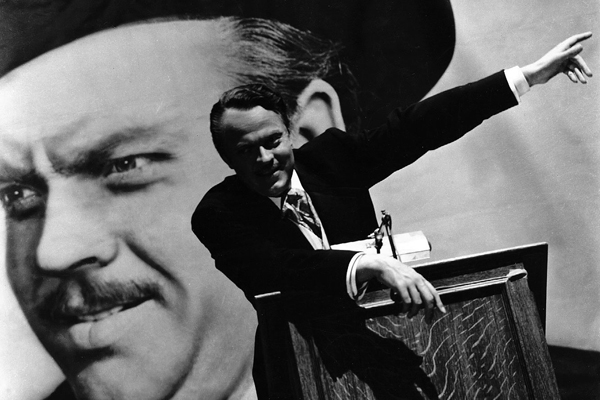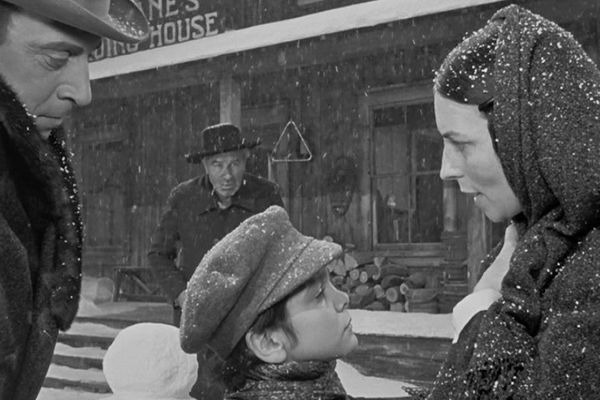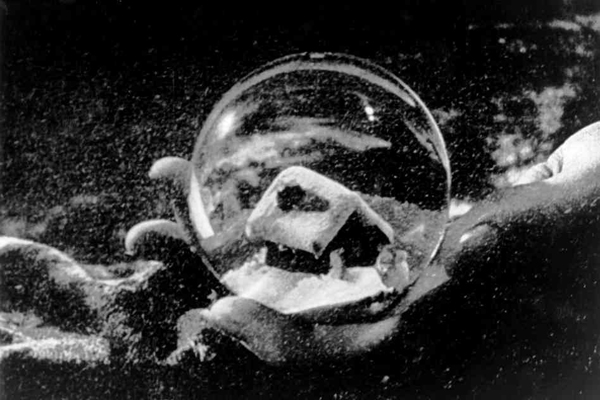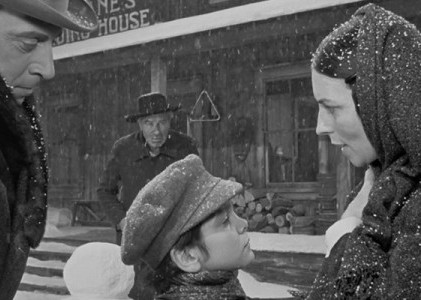Revisiting Rosebud: The Mystery of Mary Kane
Here is where this Ameriad begins, in a
Colorado cabin erected on the RKO lot in 1941 and surrounded by mounds
of asbestos flakes, and with three adults and a kid and a sled.
Something like both the Rosetta Stone and Sistine Chapel ceiling of
cinema history, Orson Welles’s Citizen Kane (1941) may have been
finally supplanted in the globe’s most authoritative film critics poll
(Sight & Sound’s) as the be-all, end-all "greatest" film ever made,
but it remains an unparalleled feat of modern cultural hubris and
textual density. In the course of 120 years of Babylonian exegesis,
ranging from fast newspaper reviews and blog ejaculates to doctoral
theses and Lacanian psychoanalytics, no other film has been analyzed and
written about so much, and no film has therein generated such a varied
and copious library of critical and analytic response. In fact, one
could go so far as to say that no film, given the warehouses of dead
trees and the warehouse servers of files in question, has remained so
defiantly raw and fresh despite the amount of discourse devoted to it. From Andre Bazin’s 1957 employment of Kane as an auteurist foundation text to Pauline Kael’s over-famous 1974 essay Raising Kane to
Laura Mulvey’s BFI Classics volume (1992) and beyond, each shipment
into the subindustry of critical address surrounding the movie cannot
help but demonstrate, the whole while, the analysis’s own singular
inadequacy, and cannot help but pale before the scope and richness of
the film itself.

Citizen Kane
If only more movies were rich enough to exhibit
this kind of fortitude. (Film criticism can kill, and certainly has on
occasion killed, a film – witness, say, how hesitantly the reevaluation
of Heaven’s Gate is still proceeding, more than three decades after its
crucified release.) What Kane has in its favor is an almost
unique gestalt that manifests its essential thematic grist – the
evasiveness of meaning, the mysteriousness of other people, the entropic
self-cannibalization of both desire and extreme wealth, the unknowable
blackness of others’ lives – in a cinematographic, editorial and graphic
Hallelujah chorus that sings those dark harmonics in every frame. The
effect is rather of a sorcerously-created world that does not require
our viewership to exist and to thrive – it’s self-contained, like that
landscape inside the snow globe, or like Xanadu itself, or like any mad
effort to recreate the world and correct its chaos, by erecting walls
and reconstructing inside what is valued, in miniature. Which, in every
case, only leads to impacted chaos, of course, whether circumstantial or
psychological or moral. It’s a Frankenstein story, and in Kane a man’s unhappy life is the experiment, defying God with its manias and laying waste to the villages.
Kane
itself is also Welles’s monster, crafted so originally and thoroughly
that its looming, voracious, Oedipal appetite destroyed him, in
Hollywood terms, and the career Welles had thereafter remains, in all
probability, the crow-picked corpse of the artistic life he could have
had, had his initial creation proven less all-consuming, less absolute.
But we needn’t reach for historicization or biography. Kane will always
resonate and ache with known unknowns because in many ways we haven’t
yet exhausted the basement of Xanadu. There are secrets here, as there
must be, as Thomson the newsreel snoop realizes himself holding the
jigsaw puzzle, right?, and every viewing of Kane is a reacquaintance
with what its logorrheic-yet-evasive narrative flow doesn’t tell us.
Seven decades later, we’re still that faceless reporter, full of
information both unreliable and of questionable integrity but only
nominally closer to whatever we might comfortably call the truth.

Citizen Kane
For
example, let us consider Mary Kane, and that initiating scene in that
fake frontier boarding house. No other scene is quite as troublingly
hermetic as this one, harboring impacted secrets we can smell like
snuffed candles, though we may not be surprised – what has more secrets,
from itself and from its members and from the outside world, than a
family? It’s the oddest backstory flashback in Golden Age history – a
family of three stuck in the snowblind wilderness in 1870, visited by a
New York banker hired to not only manage the wealth the Kanes have
stumbled into, via an errant boarder’s gift of "worthless stock" in a
mine, but to also manage their six-year-old son Charlie (seen famously
through the entire scene obliviously playing in the snow outside),
taking the boy away from his parents permanently and raising him in the
East amid prep schools and professional nannies. A favorite for
diagrammatical film scholars for ages, this scene’s first mega-shot may
be, simply in terms of mise-en-scene, the wisest and most potent scene
ever shot in America. But every firsttime viewer of Kane always stops
short during this sequence’s storytelling, wondering first at the
bizarre illogic of such an arrangement – must a nouveau riche’s ambition
for their son mean signing him away forever? Why sign him over *now*,
at such a young age? Why stay in Colorado, which wasn’t even yet a
state in 1870, at all, especially when your finances are managed on Wall
Street? Isn’t keeping the family together something this massive amount
of money can afford?
Then, Mr. and Mrs. Kane’s behavior sends up
red flags at every beat in the quadrangulated scene, Charlie romping
outside with his sled in the meantime – Jim Kane (Harry Shannon) is a
nervous, bulldozed mess, clearly not happy or satisfied with the
arrangement on which they are all to sign, while Mary Kane (Agnes
Moorehead) is a virtual sleepwalker, grimly exuding no emotion in what
should be an emotionally charged moment, and placidly plowing ahead with
the custody deal with Thatcher, which is clearly her idea. Watch it
again, if you haven’t already committed it to memory, and the one
dialogic cue that Welles and co-writer Herman J. Mankiewicz toss at us –
Mr. Kane’s impulsive but unconvincing thought to whup the boy after
Charlie goes at Thatcher with his sled, and Mrs. Kane’s
disassociative-fugue-state answer to send the boy away "where you can’t
get at him" – wilts on the vine as a possible motive for the family’s
dissolution and for the parents’ behavior. (Given a choice, any
six-year-old would choose the warm Dad over Mom’s cold-blooded
depression.) Then without ado Welles jump-cuts forward eighteen years,
to the grown Charlie giving Thatcher amused hell with yellow
journalistic stunts, and the enigmas of the Kane family are allowed to
dissolve into the mists of the past.
We must remember that the boarding house scene is derived from the account found in Thatcher’s diaries, and so like every molecule of dramatic material we have about Kane, it is potentially fictionalized by Thatcher’s subjectivities, which were not mild. Perhaps Thatcher, in his unexplored particularities, saw these two hapless Western pilgrims for one-tenth of what they were, or of what they were enduring, just as his running and disdainful opinion about Charlie for years thereafter saw only a fraction of the man’s substance. That would be one way to read the scene – as a Thatcherite sneering – but it leaves the *why* of the custodianship unanswered. What was wrong with Mary Kane, anyway?

Citizen Kane
As
far as I know, no one has ever broached a convincing theory to explain
this scene’s weirdness. When asked by my students, I’d never had one,
either. That is, until several years ago, when a returning-adult
undergrad student of mine, a Vietnam vet, seeing Kane for the first time
in a basic film history course, shrugged and offered a luminous
explanation. It’s simple, really, and implanted in what we do see in the
film like a virus: the unseen deadbeat boarder with the fortuitous mine
deed, named "Fred Graves" in the screenplay, was in fact Charlie’s
father. This would mean that Charlie was a bastard born to a wayward
married woman, which in the western territories of 1870 meant he was to
be hidden, spirited off and hopefully forgotten, regardless of how much
money one might be coming into. (Vast wealth and the social prominence
it brings might’ve made the disposal of the child even more imperative.)
This explains the custodianship arrangement, and it certain justifies
Jim Kane’s devastated uncertainty and uneasy patriarchal gestures; not
only had he been cuckolded, but now, to somehow ameliorate the
situation, he must sign over the boy he obviously loves. What’s more,
his advanced age and the absence of any other children suggests that for
all intents and purposes Jim Kane was infertile, a frontier stigma for a
family man, and Fred Graves was not.
Numb and hollowed out
inside, Mary Kane is suffering the crucible here, for her infidelity,
for her bastard offspring, for the decision to abandon him to the
gearwork of money and thereafter attempt to remake her life without the
taint of forbidden flesh. Exploring this idea logistically, you end up
asking how long ago Fred Graves had left, how long he’d stayed, how much
of Mary’s pregnancy and Charlie’s childhood he’d hung around for, and
what the Kane boarding house must’ve been like from, say, 1863 and the
flashback’s present moment. What else did Mary Kane lose? Her haunted
hiss of "where you can’t get at him," muttered in depressed mid-clinch
with the boy, hints at a disdain for her husband that he hadn’t really
earned, and perhaps this was because she loved Fred Graves, and was
loved by Fred Graves, long and hard, and didn’t want to give him up when
she should’ve, and bore Fred Graves’s child hoping it would keep him
with her, when in all likelihood it did the opposite. The Kanes may have
been emerging from a domestic catastrophe they were frayed from keeping
hidden, but Mary’s emotional life is over. That is why Mary Kane is a
zombie – hers is a broken heart that she’d ground up for meatloaf over
and over again. Everybody else, especially Charlie, is collateral damage
created by a headlong, illicit meeting of loins and lips years earlier,
before the railroads had even crossed the Rockies.
Did Thatcher
know, or care? Did Charlie himself, a grown millionaire with infinite
resources and a presumably vexed relationship with his parents, ever
find out? There are no tell-tale signs, although Kane’s overt and
rebellious Oedipality, manifested primarily as a battle with Thatcher,
would seem, because Thatcher is a proxy, to have Freudian roots in the
loss of the unknown father, and not in the distance from the ineffectual
Jim Kane. This emptiness, which Kane struggles to fill throughout his
life and the film, is Kane’s weightiest tragedy, irremediable with a
sultan’s treasure. This is what "Rosebud" is, at least in part (I’m
beginning to suspect Rosebud is *everything*), and it braids
another existential strand onto Kane’s lifelong efforts at connection
and meaning, efforts that were doomed because his own identity remained a
mystery. Welles’s film can be boiled down to the story of a Musilian
"man without qualities" seeking, because he has no self-definition, to
define himself through others, through power, through popularity,
through ownership. His inevitable failure is a cascade that began before
he was born, with a strange man in a married woman’s bed, whispering
promises he will not keep. ![]()
LATEST ARTICLES
-20140814-173707-thumb3.jpg)
Fighting Words
by Imogen Sara Smith
posted August 12, 2014

Fighting Words, Part 2
by Imogen Sara Smith
posted August 20, 2014

On the Margins: The Fil…
by Andrew Chan
posted August 12, 2014

Robin Williams: A Sense…
by David Schwartz
posted August 12, 2014
 Revisiting Rosebud: The Mystery of Mary Kane
Revisiting Rosebud: The Mystery of Mary Kane
THE AUTHOR
Michael Atkinson is the author/editor of six books, including Ghosts in the Machine: Speculating on the Dark Heart of Pop Cinema (Limelight Eds., 2000), Flickipedia (Chicago Review Press, 2007), Exile Cinema: Filmmakers at Work Beyond Hollywood (SUNY Press, 2008), and the novels from St. Martin's Press Hemingway Deadlights and Hemingway Cutthroat.
More articles by Michael AtkinsonAuthor's Website: Zero for Conduct

